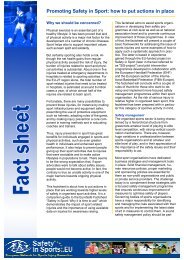Burden of Sport Injuries in the European Union - Safety in Sports
Burden of Sport Injuries in the European Union - Safety in Sports
Burden of Sport Injuries in the European Union - Safety in Sports
You also want an ePaper? Increase the reach of your titles
YUMPU automatically turns print PDFs into web optimized ePapers that Google loves.
9<br />
2 | February 2012<br />
tunities to reduce <strong>the</strong>se risks effectively. It is well established that physical activity (at<br />
least with<strong>in</strong> a wide range <strong>of</strong> <strong>in</strong>tensity) contributes to health and well-be<strong>in</strong>g and its<br />
promotion can be an effective strategy for fight<strong>in</strong>g obesity, diabetes, diseases <strong>of</strong> <strong>the</strong><br />
cardio-vascular system etc. From a public health po<strong>in</strong>t <strong>of</strong> view, it is desired that all<br />
people practice physical exercise with appropriate <strong>in</strong>tensity and that simultaneously<br />
<strong>the</strong> risks <strong>of</strong> unwanted side effect <strong>of</strong> <strong>in</strong>juries is reduced to a m<strong>in</strong>imum. The two public<br />
health strategies <strong>of</strong> promotion physical activities and promot<strong>in</strong>g safety are not well<br />
<strong>in</strong>terconnected yet, and frequently <strong>the</strong> respective policies do not refer well to each<br />
o<strong>the</strong>r.<br />
In spite <strong>of</strong> <strong>the</strong> mandate <strong>of</strong> <strong>the</strong> treaty for “protect<strong>in</strong>g <strong>the</strong> physical <strong>in</strong>tegrity <strong>of</strong> sportspersons”<br />
it seems as if policy makers, <strong>in</strong> particular <strong>in</strong> <strong>the</strong> area <strong>of</strong> sport are not fully<br />
aware <strong>of</strong> <strong>the</strong> decrement<strong>in</strong>g effect <strong>of</strong> <strong>in</strong>jury as well as <strong>of</strong> <strong>the</strong> opportunities to meet this<br />
challenge. In fact, <strong>in</strong> <strong>European</strong> sport policy documents and decisions “<strong>in</strong>juries” are<br />
hardly mentioned as a challenge. The <strong>European</strong> Commission’s White Paper on <strong>Sport</strong><br />
(Commission 2007a), which actually serves as a strategic document for sett<strong>in</strong>g up a<br />
<strong>European</strong> sport programme, does not mention sport <strong>in</strong>jury at all, while e.g. violence<br />
and dop<strong>in</strong>g are well recognized as unwanted side-effects and detrimental phenomena<br />
which need to be tackled. Only <strong>in</strong> <strong>the</strong> accompany<strong>in</strong>g Commission’s work<strong>in</strong>g document<br />
(Commission 2007b) sport-related <strong>in</strong>juries are mentioned but only as “potentially<br />
negative health effects <strong>of</strong> sport” which “have to be avoided through proper education<br />
and <strong>in</strong>formation”. It has to be questioned how <strong>in</strong>jury can be considered as a<br />
just “potentially” negative phenomenon. Per def<strong>in</strong>ition, <strong>in</strong>jury is a bodily damage<br />
creat<strong>in</strong>g a loss <strong>in</strong> terms <strong>of</strong> well-be<strong>in</strong>g and productivity e.g. due to sick-leave and<br />
medical costs for treatment and rehabilitation. Only very m<strong>in</strong>or <strong>in</strong>juries like sore<br />
muscles could be considered as positive as necessary for achiev<strong>in</strong>g tra<strong>in</strong><strong>in</strong>g effects. In<br />
pr<strong>in</strong>ciple, it is only <strong>the</strong> sport<strong>in</strong>g activity itself which can produce positive effects, e.g.<br />
<strong>in</strong> terms <strong>of</strong> sportive success, enterta<strong>in</strong>ment or health, but never an <strong>in</strong>jury. When exercis<strong>in</strong>g,<br />
<strong>in</strong>juries may be unavoidable to a certa<strong>in</strong> extent, but this does not transform<br />
<strong>the</strong>m <strong>in</strong>to a positive phenomenon.<br />
There is ano<strong>the</strong>r superficiality <strong>in</strong> <strong>the</strong> quoted sentence: Education and <strong>in</strong>formation<br />
(<strong>the</strong> so called “active strategies” <strong>of</strong> prevention) play an important role <strong>in</strong> <strong>in</strong>jury prevention,<br />
but <strong>in</strong> general, <strong>the</strong>re are o<strong>the</strong>r, and <strong>in</strong> most cases even more effective prevention<br />
strategies available like proper tra<strong>in</strong><strong>in</strong>g, safe sport<strong>in</strong>g grounds or <strong>the</strong> use <strong>of</strong><br />
protective equipment (<strong>the</strong> so called “passive strategies”). The quoted reference to<br />
“education and <strong>in</strong>formation” seems to illustrate a shortcom<strong>in</strong>g <strong>of</strong> <strong>the</strong> current understand<strong>in</strong>g<br />
<strong>of</strong> <strong>the</strong> orig<strong>in</strong> <strong>of</strong> sport <strong>in</strong>juries: The proclivity to attribute <strong>the</strong> responsibility<br />
for safety to sportswomen and sportsmen, who just need to be <strong>in</strong>formed about how<br />
to behave, or to <strong>in</strong>stitutions which are seen as responsible for education and <strong>in</strong>formation<br />
as schools and health promotion agencies. This focus, although justified <strong>in</strong><br />
many respects, ignores <strong>the</strong> importance <strong>of</strong> “passive” safety strategies and underesti-



